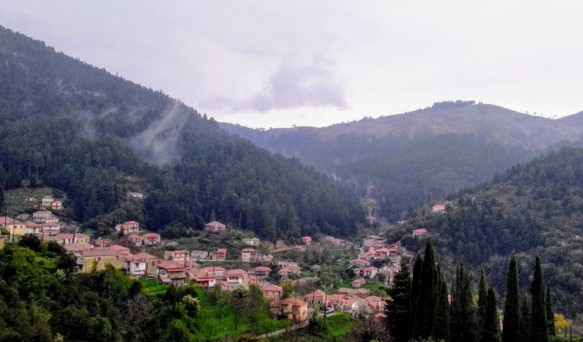The valley of Sparta is surrounded by towering mountains which cradle countless villages. Winding through a myriad of summits, about one hour slightly northeast, one reaches the remote village of Tsintzina, known today as Polidroso. Nestled in a forest of fir trees in the heart of Mt. Parnon, Tsintzinia’s history dates back to at least the 12th century. There is an oral tradition that German soldiers participating in the Crusades visited the village and some intermarried with Tsintzinian women.
Nestled in a forest of fir trees in the heart of Mt. Parnon, Tsintzinia’s history dates back to at least the 12th century. There is an oral tradition that German soldiers participating in the Crusades visited the village and some intermarried with Tsintzinian women.
The villagers lived peacefully even during centuries of Ottoman rule. The earliest relocations to the Evrotas valley near Sparta began around 1777 after the Orlov Insurrection. Others followed after the 1821 Revolution. As people established permanent homes in the valley, they kept their mountain homes for summer residences.[1]
Theodore Saloutos called the first wave of immigrants from Greece “Greek Pilgrims,” those who migrated from villages surrounding Sparta in the 1880s. Tsintzinians were given this name, as they were among the earliest Greeks to establish communities in America. Christos Chaconas (Tsakonas) came to the U.S. about 1873 and commenced the pattern of bringing a succession of young men to America and providing them with jobs, as described in this National Herald article.
By 1887, enough Tsintzinian men had emigrated to Chicago to form “the first organization in America exclusively for Greeks and named it the Therapnean Society after the name of the township or demos in the old country.”[2] This photo, sent to me by JoAnn Pavlostathis, was taken in Chicago during the very early 1900’s. [click on photo to enlarge and see annotated numbers]
Names Transcribed:
1. James J. Polites (Gioras)
2. Athanasios Farmakis (Colovos)
3. Constantinos Vouloumanos (Bogris)
4. Fraklis Trieris
5. Demetrios J. Vouloumanos (Moutsonas)
6. Panagiotes N. Georgetsos
7. Panagiotis J. Vouloumanos (Moutounas)
8. Elias Polites (Makris)
9. Elias Polites
10. James A. Vouloumanos (Snibas)
11. Panagiotis Grigoris Patrosis
12. Elias Economou (Fantaros)
13. James N. Chelekis
14. –
15. Michael G. Laskaris
16. Nicholas A. Gregoris
17. Haralambos Coumoutzis
18. James K. Poolos
19. Laskaris
20. Economakis (Magoula)
21. Panagiotes Polites
22. Demetrios P. Polites
23. Nick Caroumbas
24. –
25. John Polites (Kleftakis)
26. Nicholas G. Caravasios
27. –
28. Panagiotis Limberakis
29. Nick Vambalis (Karahalios)
30. Antonios Stathopoulos (Magoula)
31. Harry N. Constas
32. Demetrios J. Comuntzis
33. George J. Gregory
34. Nicholas P. Farmakis
35. Nick Gianios
36. Panagiotis Laskaris
37. Leonidas Serfelis
38. Anastasios Economakis (Klemizis)
39. John G. Papageorge
40. John Trieris
41. John Geracimos (Kotsaris)
42. John Chacona
43. James J. Nickles
44. George Duskas
45. Vasileios J. Lourpas
46. Baby John Nickles
47. Marcus Jmes Nickles
48. Baby of John Chacona
Nick G. Carvasios
813 Main Street
Wheeling, W.Va. 26003
Every July for the past 130 years, members of the Tsintzinian Heritage Society hold a reunion in Jamestown, New York to strengthen their bonds and maintain their traditions. The society has gathered a history of the families of the village, found here. Members continue to submit surname information (found here) which makes it easy to locate and connect with originating families from the village.
In addition, the Tsintzina website is filled with a myriad of information about the village: its history, culture, photos, books, links, and even a phone directory of villagers!
For those with families from Tsintzina, there are many resources to learn the proud history of your roots.
________
[1] Peter Dickson to Carol Kostakos Petranek, 2016
[2] Dickson, Peter. General History, “Tzintzinian Heritage Society of America.”



